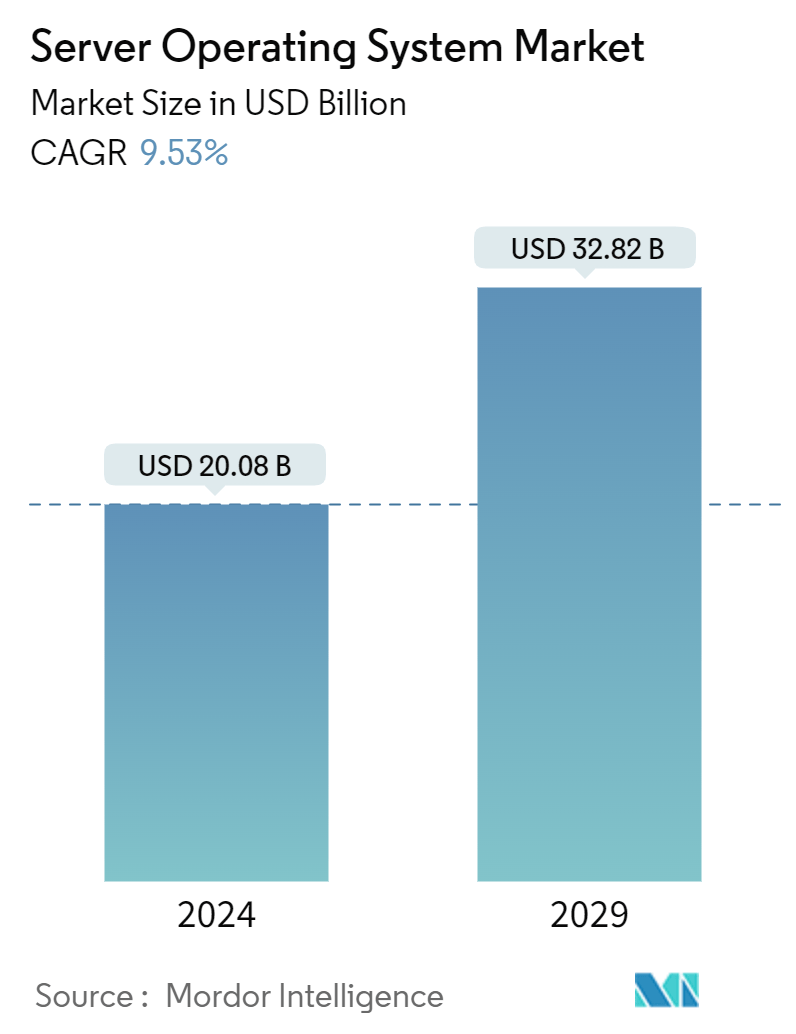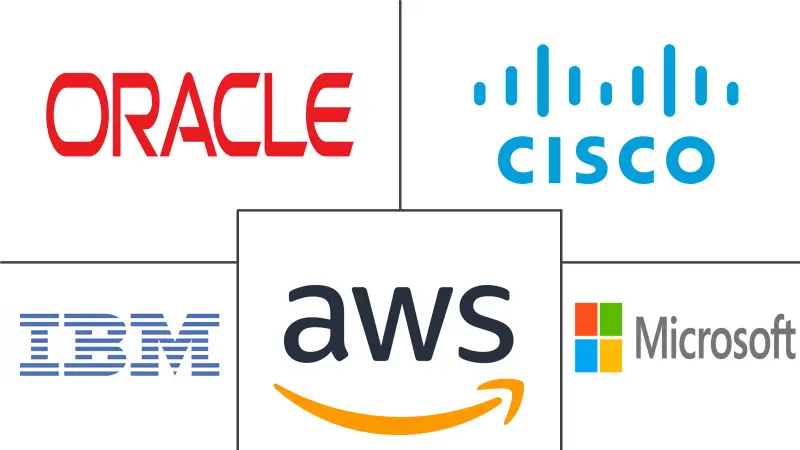Market Size of Server Operating System Industry

| Study Period | 2019 - 2029 |
| Market Size (2024) | USD 20.08 Billion |
| Market Size (2029) | USD 32.82 Billion |
| CAGR (2024 - 2029) | 9.53 % |
| Fastest Growing Market | Asia Pacific |
| Largest Market | North America |
Major Players
*Disclaimer: Major Players sorted in no particular order |
Server Operating System Market Analysis
The Server Operating System Market size is estimated at USD 20.08 billion in 2024, and is expected to reach USD 32.82 billion by 2029, growing at a CAGR of 9.53% during the forecast period (2024-2029).
The market's growth is attributed to enterprise spending on creating a robust data center infrastructure. In addition, the increasing adoption of hybrid cloud environments and deployment of 5G networking technologies fuel the market's growth. Further, technological advancements and increasing security requirements in infrastructure are anticipated to provide lucrative expansion opportunities for the market during the forecast period.
- Increasing adoption of cloud platforms & infrastructure and rising data center infrastructure investments by most of the prominent players are assisting the market growth. The development of current advanced infrastructure is anticipated to boost the number of cloud server users worldwide. The key cloud computing service firms are investing a considerable portion of money in expanding cloud infrastructure around the globe. For instance, In February 2023, Oracle Corporation announced a new plan for public cloud in Saudi Arabia with an investment of USD 1.5 billion, considering the increasing demand for cloud services.
- Servers can be used in various applications in smart cities, including delivering high-performance, low-latency services such as 5G and AI applications for intelligent transportation systems (ITS) and vehicle-to-everything (V2X) communication. They can also be used to host cloud-based voice-over-IP (VoIP) communication systems for public transportation and storing and managing data from IoT sensors and devices.
- Additionally, high-availability servers can play a role in smart city services' security and authentication processes. For example, Globally, many smart city projects and efforts are being implemented, encouraging global investments owing to urbanization. The OECD estimates that between 2010 and 2030, international investments in smart city initiatives would total around USD 1.8 trillion for all urban city infrastructure projects. This would create an opportunity for the players to develop a new version of OS to capture the market share.
- To expand their market share, the market players are incorporating new strategies; for instance, In July 2023, CIQ, which builds software infrastructure for enterprises running workloads atop the Rocky Linux enterprise Linux distribution, announced today the launch of its CIQ Partner Program. The company said the launch reinforces CIQ's partner-first channel strategy as it aims to deliver its suite of solutions and services to organizations worldwide that desire stability, seamless compatibility, and cost-effectiveness for their IT infrastructure and high-performance computing needs.
- The CIQ Partner Program is ideal for resellers and integrators selling to enterprises and government organizations deploying and managing infrastructure at scale, data-intensive workloads for product development, scientific research, modeling, machine learning, and AI.
- However, the expanded interest in server operating systems with customized arrangements for a few applications & the many difficulties related to choosing a reasonable server is expected to affect the market development negatively. Besides, high establishment & support expenses represent a test to advertise product during the forecast period. In any case, the Bring Your Device Policy (BYOD) & the rising requirement for unified admittance frameworks are considered to assist with keeping the interest up for servers over the forecast period.
Server Operating System Industry Segmentation
A server operating system is a type of operating system intended for installation and operation on the server computer. It is an advanced operating system with features and functionalities necessary for a client-server system or enterprise computing environment. Moreover, a server operating system has been developed from the ground up to support multi-user, business-critical applications. It is the primary interface for managing users, implementing security, and carrying out other administrative tasks.
The global server operating system market is segmented by component (software, service), by type (windows, Linux, UNIX, and other types), by virtualization (virtual server, physical server), by deployment mode (cloud and on-premise), by enterprise size (large enterprises and small and medium-sized enterprises (SMEs)), by industry vertical (IT and telecom, BFSI, manufacturing, retail and e-commerce, government, healthcare, and other industry verticals), and by geography ( North America, Europe, Asia Pacific, Latin America, and Middle East and Africa).
The market sizes and forecasts are provided in terms of value (in USD) for all the above segments.
| By Component | |
| Software | |
| Service |
| By Type | |
| Windows | |
| Linux | |
| UNIX | |
| Other Types |
| By Virtualization | |
| Virtual Server | |
| Physical Server |
| By Deployment Mode | |
| Cloud | |
| On-premise |
| By Enterprise Size | |
| Large Enterprises | |
| Small and Medium-sized Enterprises (SMEs) |
| By Industry Vertical | |
| IT and Telecom | |
| BFSI | |
| Manufacturing | |
| Retail and E-Commerce | |
| Government | |
| Healthcare | |
| Other Industry Verticals |
| Geography | |
| North America | |
| Europe | |
| Asia | |
| Australia and New Zealand | |
| Latin America | |
| Middle East and Africa |
Server Operating System Market Size Summary
The server operating system market is poised for significant growth, driven by increased enterprise investment in data center infrastructure and the rising adoption of hybrid cloud environments. The deployment of 5G technologies and advancements in security requirements are further propelling market expansion. Key players in the cloud computing sector are heavily investing in expanding their infrastructure, which is expected to boost the number of cloud server users globally. This growth is also supported by the development of smart city applications, where servers play a crucial role in delivering high-performance services and managing data from IoT devices. However, challenges such as high establishment and support costs, along with the need for customized server arrangements, may pose obstacles to market growth.
The market is characterized by a moderate level of consolidation, with major players like Oracle, Cisco Systems, IBM, Amazon Web Services, and Microsoft Corporation actively investing in strategic partnerships and product developments to enhance their market share. The increasing adoption of cloud computing technologies, particularly in North America, is a significant driver of market growth. Virtualization technologies and the booming 5G deployments are also contributing to the demand for server operating systems. As organizations continue to migrate to cloud environments for improved security and agility, the market is expected to see substantial expansion, offering lucrative opportunities for vendors to develop and offer new solutions.
Server Operating System Market Size - Table of Contents
-
1. MARKET INSIGHTS
-
1.1 Market Overview
-
1.2 Industry Attractiveness - Porter's Five Forces Analysis
-
1.2.1 Bargaining Power of Buyers
-
1.2.2 Bargaining Power of Suppliers
-
1.2.3 Threat of New Entrants
-
1.2.4 Threat of Substitutes
-
1.2.5 Intensity of Competitive Rivalry
-
-
1.3 Industry Value Chain Analysis
-
1.4 Assessment of the Impact of COVID-19 on the Market
-
-
2. MARKET SEGMENTATION
-
2.1 By Component
-
2.1.1 Software
-
2.1.2 Service
-
-
2.2 By Type
-
2.2.1 Windows
-
2.2.2 Linux
-
2.2.3 UNIX
-
2.2.4 Other Types
-
-
2.3 By Virtualization
-
2.3.1 Virtual Server
-
2.3.2 Physical Server
-
-
2.4 By Deployment Mode
-
2.4.1 Cloud
-
2.4.2 On-premise
-
-
2.5 By Enterprise Size
-
2.5.1 Large Enterprises
-
2.5.2 Small and Medium-sized Enterprises (SMEs)
-
-
2.6 By Industry Vertical
-
2.6.1 IT and Telecom
-
2.6.2 BFSI
-
2.6.3 Manufacturing
-
2.6.4 Retail and E-Commerce
-
2.6.5 Government
-
2.6.6 Healthcare
-
2.6.7 Other Industry Verticals
-
-
2.7 Geography
-
2.7.1 North America
-
2.7.2 Europe
-
2.7.3 Asia
-
2.7.4 Australia and New Zealand
-
2.7.5 Latin America
-
2.7.6 Middle East and Africa
-
-
Server Operating System Market Size FAQs
How big is the Server Operating System Market?
The Server Operating System Market size is expected to reach USD 20.08 billion in 2024 and grow at a CAGR of 9.53% to reach USD 32.82 billion by 2029.
What is the current Server Operating System Market size?
In 2024, the Server Operating System Market size is expected to reach USD 20.08 billion.

